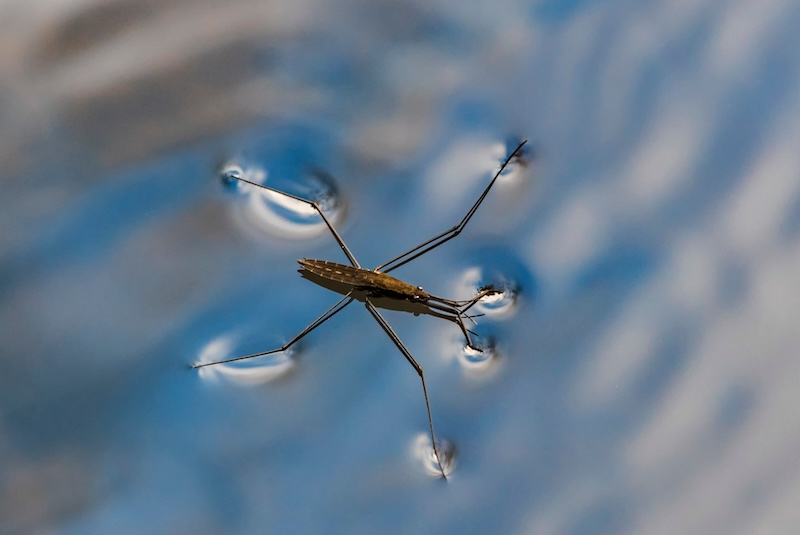Rainproof Water Striders
Water striders—lightweight insects that can walk on water—can spend their entire lives gliding across lakes and ponds. But it’s not all plain sailing—when violent storms hit, raindrops dozens of times larger than the insects bombard the water’s surface. Yet the insects come away unharmed. Now a team led by Andrew Dickerson of the University of Tennessee, Knoxville, has an explanation for how water striders withstand being hit by raindrops [1]. The results could help scientists understand how rain affects the transport of tiny particles, such as microplastics, through aquatic ecosystems.
Dickerson came up with the idea to study water striders on a rainy jog through the University of Central Florida’s campus, where the ponds teem with the insect. To the insects, he thought, raindrops hitting the pond’s surface must reverberate like the explosions of bombs. “What do these tiny bugs do when it rains?” he asked himself. The problem, it turned out, had not previously been explored.
For their experiments, the team used a “rain simulator,” a device that mimics rainfall on a pond. The experimental drops were all about 4 millimeters in diameter, a diameter comparable with that of large natural raindrops. Falling from a few meters, the drops reached speeds of up to 6 meters per second by the time they hit the water striders resting on the artificial pond. The team filmed the impact of the drops on the water striders using a high-speed camera.
From the recorded movies, the team deduced that the impact of a drop on a strider triggers the following sequence of events. First, as the drop hits the surface a crater develops that pushes the strider underwater. The surface of the crater then rebounds, and a jet of liquid propels vertically upwards from the crater’s center. Depending on the insect’s position relative to the jet, the jet can launch the water strider into the air. But a strider can also get trapped within the boundaries of a secondary crater produced when the jet collapses back into the liquid. This crater then drags the trapped striders underwater. In their experiments, the researchers found that, in both cases, all water striders survived the drop impact.
The researchers showed that mechanical stresses induced on a water strider’s body were well below safe limits for a strider, as determined by separate experiments in which they compressed a strider’s exoskeleton to the point of rupture. These stresses come both from compression forces from the falling drops and from inertial forces induced by acceleration of the water around the point of impact. After submersion, a strider quickly reemerges by using “power strokes” to reach the surface and by grabbing onto floating particles. While submerged, the strider can exploit its plastron—a bubble the insect carries around its hydrophobic body—as a temporary source of air. Thanks to the plastron, striders can survive several minutes of submersion, says Dickerson.
The movies revealed that the biggest submersion danger came from the secondary crater. While smaller in size than the first, the second crater is typically narrower and shallower and thus collapses much faster, enveloping the strider and pushing it underwater. But the water striders still resurfaced unscathed. Sunghwan Jung, who directs a bio-inspired fluids lab at Cornell University, says that “the researchers made a valuable contribution to our understanding of how living organisms interact with and adapt to their natural environments.” Tadd Truscott, a fluid dynamics specialist at King Abdullah University of Science and Technology in Saudi Arabia, says that the importance of the second crater on the water strider is an entirely novel finding. “I was surprised that the second crater rather than the first, bigger one is the one likely to cause the striders to sink into the fluid,” he says.
Dickerson says that the findings for water striders could help scientists understand the water transport of microplastics—plastic fragments that are less than 5 mm in length. These particles pose significant risks to human and animal health. Like water striders, microplastics are light and water repellent. If submerged by raindrops, microplastics may become harder to clean up and could therefore be more likely to contaminate marine life, he says. Dickerson and his team plan to carry out experiments that study the impact of rainfall on the underwater transport of microplastic particles, pinpointing the role of factors such as density, size, or the presence of polluting surfactants in their movements.
–Matteo Rini
Matteo Rini is the Editor of Physics Magazine.
References
- D. A. Watson et al., “Water striders are impervious to raindrop collision forces and submerged by collapsing craters,” Proc. Natl. Acad. Sci. U.S.A. 121 (2024).





